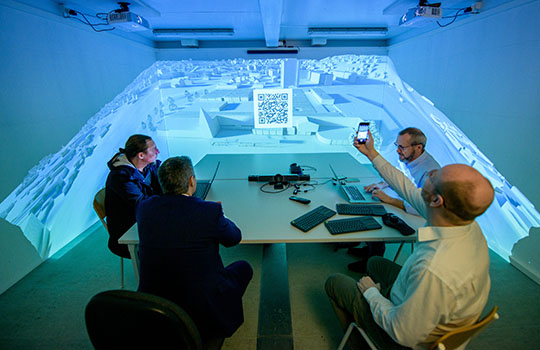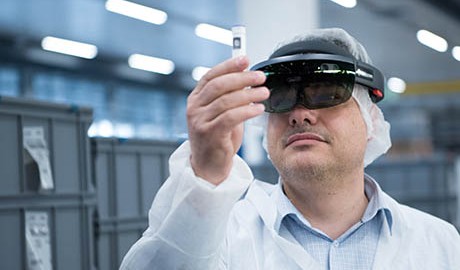More efficient building sites with 5G
How 5G is improving collaboration on construction sites
In building projects, time and cost pressure are the major challenges. Close cooperation and timely communication between all parties help, and technologies like virtual reality and 5G can improve this interaction. A pipe dream? By no means, as a visit to a present-day construction site shows.
Text: Andreas Heer, Images: Boris Baldinger,
A normal work day at the construction site in Herblingen, Switzerland, where Migros Ostschweiz is currently redeveloping the largest shopping mall in the canton of Schaffhausen. There you will find a construction container that looks quite normal from the outside. Inside, Ralf Balgar is sitting at a table with three building company representatives. He is in charge of the Herblinger Markt redevelopment project for Migros Ostschweiz, which is planned for completion in about a year – an ambitious deadline that will only be met through close collaboration and communication between all of the parties involved.
The four experts are engaged in an intense discussion on how to proceed with the project. The technical model of the redevelopment is projected onto three walls. The 270-degree projection in the “icCUBE” is life-size, offering all four people an immersive perspective of the planned building – without VR goggles. Ralf Balgar navigates to the area the four builders want to address. After a brief discussion, they decide what has to be done that day. The redevelopment project can proceed without any misunderstandings.
A “digital twin” for simpler collaboration
The construction sector is in the midst of digital transformation. State-of-the-art methods, such as building information modelling (BIM), create a three-dimensional digital twin which also includes all building service installations. The 270-degree projection in the icCUBE means all parties can take a digital tour of the model, and they see exactly what they would see if they were surveying the actual construction site together. Anyone who cannot be physically present can port in via web browser – even from a smartphone if they are on the go.
This allows builders and users to actively participate in construction planning early on, eliminating the commonly uttered phrase “... if I had only known that earlier...” – because all decision-makers are involved when they need to be. That saves time and money. “It’s allowed us to improve coordination on the construction site,” adds Project Manager Balgar. “And that prevents incorrect decisions.”

The icCUBE allows participants to literally enter a virtual reality. (This photo was taken pre-pandemic.)
For the construction industry, this “immersive” type of collaboration offers a real opportunity for reinvention and a way to eliminate past inefficiencies. Costly problems resulting from inadequate planning or tolerance errors can be identified and corrected early on with the 3D model. The outcome of any changes can be examined ahead of time. For example, the Migros store planner can meet with the lighting specialists to optimise the later customer experience, all well before the construction project begins. In other words, the immersive collaboration revolves around people. Improved communication speeds up projects and keeps costs down.
The network has to keep up
This type of communication requires a reliable mobile network. Unlike streaming a film at home, for example, immersive collaboration requires data to flow in all directions, and the full-duplex mode offered by 5G makes this mode of communication much simpler. This also generates a lot of data. The full rendering of a digital twin can quickly generate several terabytes of data. As a frame of reference, one terabyte of data is equivalent to 300 hours of movie streaming in HD quality.
The transmission of immersive 3D models in the icCUBE also requires a low-latency, fast connection, so that all participants have the same view at the same time. Over the course of the construction project, the icCUBE construction container may need to move as well. A mobile internet connection makes this easier, since no cables have to be rerouted. This is why a fixed wireless access (FWA) solution was recently set up at the construction site in Herblingen. The mobile access point connects the icCUBE to the internet via 5G.
More time – and human interaction
Ralf Balgar sees the icCUBE mainly as a multifunctional space for interdisciplinary cooperation: “The icCUBE makes it possible for everyone to share knowledge and simplifies the discussion process during the entire construction project.” Each person involved can focus on their tasks. Thanks to icCUBE, they are literally in the picture.
Exchanging information in this way improves the efficiency of building projects and addresses the main challenges facing the industry: time and cost pressure. “We’re getting faster and we’ve been able to continuously make improvements. This also increases the added value for the construction companies that are involved,” says Balgar. Downtime for subsequent fixes and improvements can be eliminated along with any uncertainty about responsibility for any additional costs.
According to Balgar, the icCUBE is a communication tool: “People discuss things more intensively and work better together as a result,” he says, before going back out to the real-world construction site.
icCUBE and immersive collaboration
Immersion is the experience of entering virtual, artificial worlds, creating an experience that allows people to form a direct emotional – and sometimes even physiological – connection. In the past, this effect was usually offered through VR goggles.
The Immersive Collaboration Cube (icCUBE) developed by the company Inside Reality offers an effective type of group immersion, without VR goggles or other 3D equipment. CTO Chris Henn describes it as “VR without goggles”. Three computers are connected to three projectors that project a 270-degree image on the walls, offering viewers an immersive experience as a group. The 5G connection also enables consistent quality of service (QoS). The icCUBE is the product of a technical collaboration between Inside Reality and Swisscom and was unveiled for the first time at Swissbau 2020 in Basel.
More on the topic





